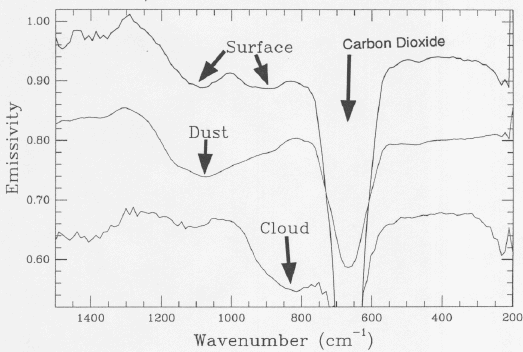|
TES Spectra of Mars Properties

Early Results from MGS Thermal Emission Spectrometer.
This picture shows what Mars Global Surveyor's TES data
look like. This graph is called a "spectrum". The each "squiggly
line" represents the spectrum of a different spot on Mars. The first
spectrum (top) shows some features caused by minerals on the
martian surface. The second spectrum (middle) shows a curve
caused by dust in the atmosphere of Mars. The third (bottom)
shows a curve caused by water ice clouds in the martian atmosphere.
All three spectra show a deep feature caused by the carbon dioxide of
Mars' thin atmosphere. "Wavenumber" represents the frequency (like
the frequency of a radio station) of infrared energy seen by TES.
The "Wavenumber" units are, basically, the number of light vibrations
per centimeter.
For TES News Article Related to This Figure, See...
MGS and TES Update, December 19, 1997
by Greg Mehall
TES News is published quarterly by the Arizona Mars K-12 Education
Program. This newsletter may be copied for EDUCATIONAL PURPOSES ONLY.
EDITED BY Kenneth S. Edgett, Arizona Mars K-12 Education Program,
Arizona State University, Tempe, Arizona, USA.
E-mail: ken.edgett@asu.edu
|



